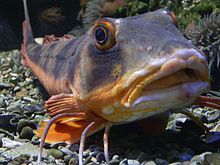Red gurnard
| Red gurnard | ||||||||||||
|---|---|---|---|---|---|---|---|---|---|---|---|---|

Red gurnard ( Chelidonichthys lucernus ) |
||||||||||||
| Systematics | ||||||||||||
|
||||||||||||
| Scientific name | ||||||||||||
| Chelidonichthys lucernus | ||||||||||||
| ( Linnaeus , 1758) |
The red gurnard ( Chelidonichthys lucernus , syn .: Trigla lucerna ) is the best known type of gurnard within the order of the perch-like . Its distribution area extends from Norway to North Africa, and it can also be found in the North Sea, the Mediterranean and the Black Sea.
features
The red gurnard has an elongated body with a very large head that narrows towards the back. It reaches an average body length of 50 centimeters, the maximum length can be up to 70 centimeters. The head has a large, very wide and terminal mouth with fleshy lips. The teeth on the jaws and the roof of the mouth are brush-like. The head is armored with numerous bars and the gill and front gill covers are studded with spines. The back and the flanks are reddish brown and marked by dark transverse bands and spots, the belly is pink or white. The head is red and the top of the wing-like pectoral fins have brown spots and a noticeable blue border.
The pectoral fins are wing-like, the foremost three hard rays have no fin skin and are freely movable as individual rays. The pelvic fins are throaty and at the base of the dorsal fin there are 24 to 25 bone spines that are arranged in rows. The dorsal fin is divided, the first hard-radiating dorsal fin is much shorter and higher than the second soft-rayed. The front dorsal fin consists of 9 to 10 hard rays, the second of 16 soft rays. The anal fin has 14 to 16 soft rays and the pectoral fin has 10 to 11 soft rays in addition to the 3 individually standing hard rays.
distribution
The red gurnard is found in the northeastern Atlantic from Norway and the North Sea to West Africa as well as in the Mediterranean and the Black Sea .
Way of life
The fish live mainly on sandy, silty and scree bottoms at a depth of 20 to 300 meters, where they feed on crustaceans , molluscs and small fish. The family is named for its ability to make growling or grunting noises. These noises are made by the fish using a muscle that makes the two-chambered swim bladder vibrate.
The spawning season falls from May to July. The eggs are released into the open water and float in the surface water due to stored oil droplets.
Importance to humans
Gurnards are popular and very high quality food fish.
supporting documents
- ↑ a b c d e f Andreas Vilcinskas : Fish - Central European freshwater species and marine fish of the North and Baltic Seas . BLV Verlagsgesellschaft, Munich 2000; P. 168. ISBN 3-405-15848-6 .
- ↑ a b Red Gurnard on Fishbase.org (English)
literature
- Andreas Vilcinskas : Fish - Central European freshwater species and marine fish of the North and Baltic Seas . BLV Verlagsgesellschaft, Munich 2000; P. 168. ISBN 3-405-15848-6 .
Web links
- Red Gurnard on Fishbase.org (English)


